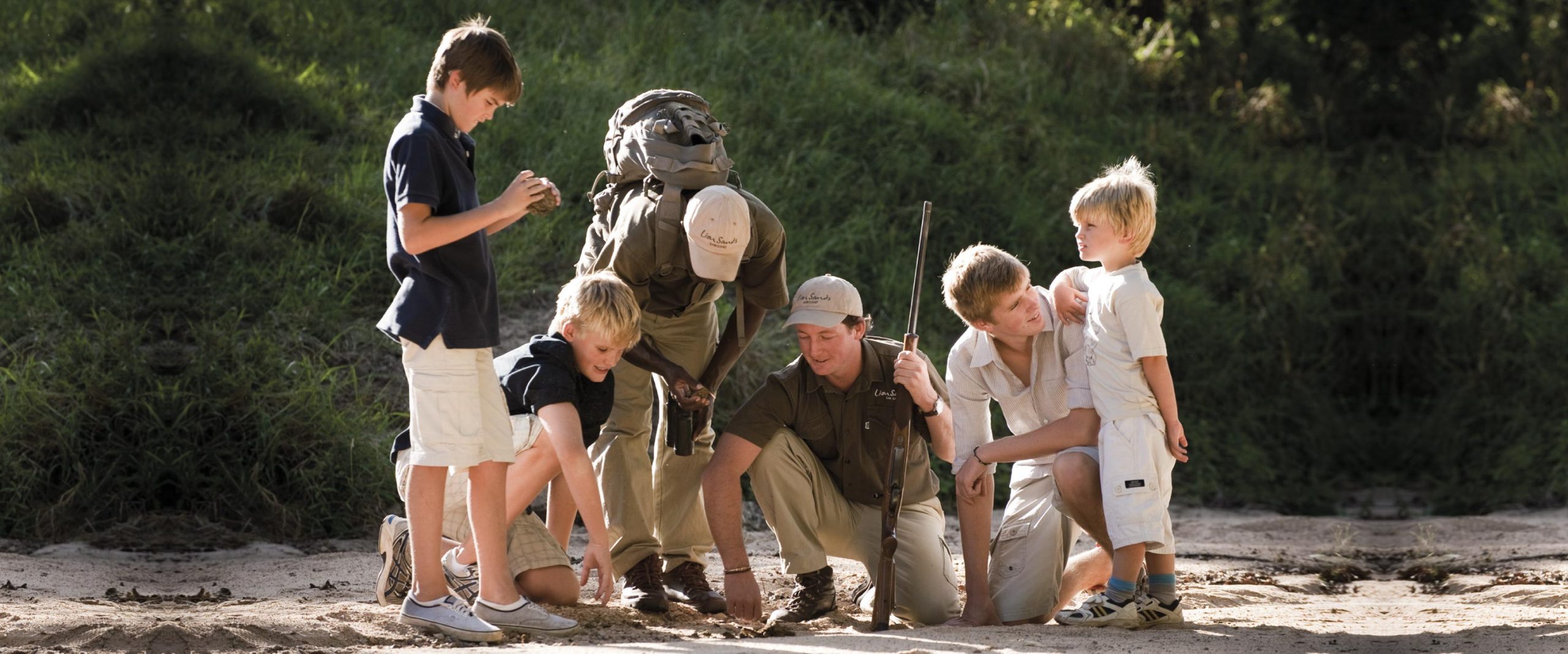
Most safari camps/lodges have not always been very child friendly. They tend to take the tack that safaris are better enjoyed in peace and quiet, without any little ones running around. Fortunately for families, this attitude has been changing over the last decade or so. Nowadays children are not merely tolerated, but are actually welcomed.
Of course, young children need to be kept busy, so many camps/lodges have come up with some novel ways of breaking up the regular safari routine.
Here are some ideas for your next family safari:
A few lodges have devised some innovative programmes to help children feel more involved on safari. Usually kids receive a backpack filled with caps, t-shirts, and books. Your safari guide then helps them to collect any items they need, to answer their quizzes and to make some fun tools. At the end, they become an official ‘Junior Ranger’ and have some bragging rights to take home to their friends.
At Tswalu Kalahari, the Junior Ranger Programme has kids making their own bow-and-arrow and testing their handiwork with archery lessons, then heading out on spoor identification and casting, as well as tracking on foot – all highly educational and lots of fun for children of all ages.
A few lodges have devised some innovative programmes to help children feel more involved on safari. Usually kids receive a backpack filled with caps, t-shirts, and books. Your safari guide then helps them to collect any items they need, to answer their quizzes and to make some fun tools. At the end, they become an official ‘Junior Ranger’ and have some bragging rights to take home to their friends.
At Tswalu Kalahari, the Junior Ranger Programme has kids making their own bow-and-arrow and testing their handiwork with archery lessons, then heading out on spoor identification and casting, as well as tracking on foot – all highly educational and lots of fun for children of all ages.
The size and danger factors of big-game animals on safari can make them difficult for children to relate to. A micro safari allows kids to walk around the camp/lodge and look for interesting mini-beasts, such as lizards, insects, snakes, and scorpions. By actually holding these creatures and examining them under a magnifying glass, kids get much more of a connection with nature.
Londolozi’s Cubs programme is a pure delight. It orientates around the ‘Cub’s Den’ and features a fish pond for splashing around in, Land Rovers to ‘drive’, campout tents for adventures, and an educational centre where wildlife takes main stage. Here kids can go bug catching, dung spotting, and animal identifying with microscope and checklist in hand.
Everyone loves a good treasure hunt, and it certainly gets children even more excited about exploring their surroundings. Think of some novel items, such as porcupine quills, bird feathers, seed pods, and antelope droppings. First one to find them all gets to ride on the tracker’s seat. At Ulusaba Rock Lodge, a welcome treasure hunt for kids makes for a really adventurous afternoon, as well as an opportunity for them to familiarise themselves with their surroundings. It’s a thrilling introduction to the area and a great way to get the children interested in exploring the stunning setting.
If there is a river or large dam nearby, chances are the camp/lodge will have some basic fishing gear. This sounds like more of a boys’ activity, but you might be surprised how quickly little girls get competitive when there is the chance to catch a bigger fish than their brother has got – and they usually win. Strictly catch and release. Ideal for families, Chongwe River House is located in tiger fish country and offers unparalleled angling opportunities. Kids can try their 10-to-2 cast with tiger fishing along the Zambezi or drop their rods just off the banks of the Chongwe River to catch some bream.
This is similar to the micro safari, but the focus here is completely on frogs. Because frogs are more active at night, this activity is better suited to older children. Find a small, shallow waterhole with your safari guide after dinner. Strap on your head torches and be sure to bring a bucket along with you. Then jump in and catch as many frogs as you can to identify them at the end of the evening. Not for those who don’t like to get muddy and slimy.
This unique activity is not something openly offered as part of the standard safari programme, but all children are invited to go frogging in Phinda Game Reserve. Phinda features seven different habitats and can have up to 40 species of frog. The best time to go frogging is during the rainy season between November and March, when the kids can look out for the brightly coloured and exotic species, such as the water lily frog, painted reed frog, and leaf-folding frog. For families with children above the age of eight, why not try &Beyond’s Phinda Mountain Lodge?
Some camps/lodges have a few bows-and-arrows for your kids to practise their archery skills. This can be another fun way to pass the time between safaris when the adults are having a siesta. It definitely gets the competitive juices flowing, and it is always a lot of fun for fathers and sons to go head to head. The tips on the arrows are blunt in order to avoid any injuries.
At Sasaab Lodge, they take it one step further. The children can go out with the local Samburu guides, who will take them under their wing to teach them how to make traditional bows-and-arrows. Afterwards, they’ll be taught how to aim and shot the arrows at targets before taking part in the Samburu Olympics, which includes javelins and rungu throwing as well.
When you go on safari, take some plaster of Paris out with you. If you see any interesting tracks in the mud or sand, you can make an exact replica of them in about an hour. Lion, leopard, cheetah, or hyena tracks tend to work. Once your child’s name has been inscribed on the plaster plate, it is sure to become one of their most prized possessions.
Tuningi Safari Lodge is a fantastic family-friendly property where, as well as plaster casting, the children can go on shorter ‘bumble’ game drives, go on treasure hunts, and enjoy clay modelling.
At mealtimes, the chefs are usually more than happy to have the children spend some time with them in the kitchen. Kids can learn the art of baking and make dozens of animal-shaped cookies and cakes. They could even create their own pizzas from start to finish and come up with a menu of their own. Because, you know, adult food can just be so boring sometimes.
